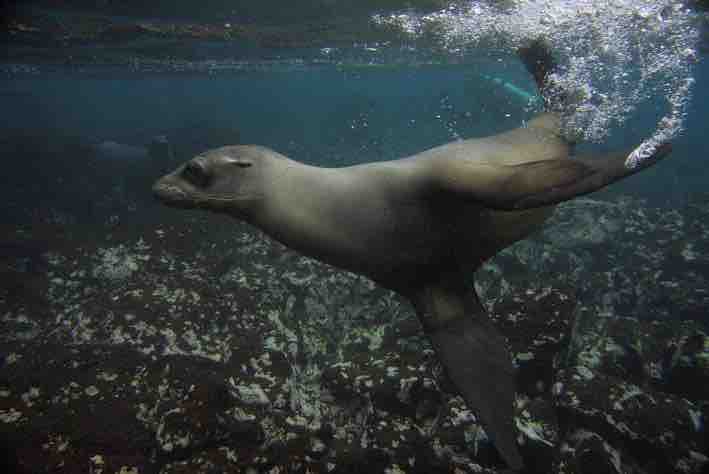Fotografía de Andrés Moreira-Mendieta
Resumen
Los ecosistemas tropicales representan un desafío para los pinípedos debido a la variabilidad en la disponibilidad de alimentos. Según investigaciones previas, el lobo marino de las Galápagos (GSL, Zalophus wollebaeki) adopta flexibilidad trófica para hacer frente a estas condiciones. Sin embargo, esta hipótesis se basa en estudios que utilizan métodos tradicionales (análisis de partes duras de heces e análisis isotópico de tejidos). En nuestro estudio, analizamos la dieta de cinco colonias en la región biogeográfica sureste de las Galápagos (que alberga la mayor densidad de GSL) mediante ADN-metabarcoding de muestras de heces. El enfoque de ADN-metabarcoding puede identificar presas consumidas con una resolución taxonómica superior al análisis isotópico, sin depender de partes duras que permanezcan después de la digestión. Nuestro estudio incluyó cinco colonias diferentes para buscar evidencia de flexibilidad trófica a nivel bioregional. Detectamos 98 OTUs de presas (124 heces), en su mayoría asignadas a taxones de peces óseos; identificamos nuevas presas, incluyendo un tiburón, rayas y varios peces de aguas profundas. Nuestros datos respaldaron la flexibilidad trófica de GSL en toda la región biogeográfica estudiada, ya que diferentes individuos de la misma colonia consumían presas procedentes de hábitats y niveles tróficos diferentes. Se encontraron diferenciaciones significativas en la dieta entre colonias, especialmente entre Punta Pitt y Santa Fe. La colonia de Punta Pitt, con una batimetría más pronunciada y menor productividad, se distinguió por un alto nivel trófico y el consumo de una alta proporción de presas de aguas profundas; mientras tanto, Santa Fe, ubicada en aguas más productivas y someras sobre la plataforma, consumía una alta proporción de peces epipelágicos planctívoros. La ubicación geográfica y la batimetría heterogénea de las colonias de El Malecón, Española y Floreana permitirían a los animales acceder tanto a presas epipelágicas sobre la plataforma como a presas de aguas profundas fuera de la plataforma; esto conduciría a una mayor riqueza de presas y variabilidad en la dieta. Estos hallazgos proporcionan evidencia de que el GSL adopta una flexibilidad trófica para ajustar sus dietas a diferentes contextos ecológicos. Esta estrategia sería crucial para que esta especie en peligro supere los desafíos en un hábitat con condiciones de alimentación fluctuantes.
Conoce más del artículo científico en el siguiente enlace: https://doi.org/10.1002/ece3.10921






